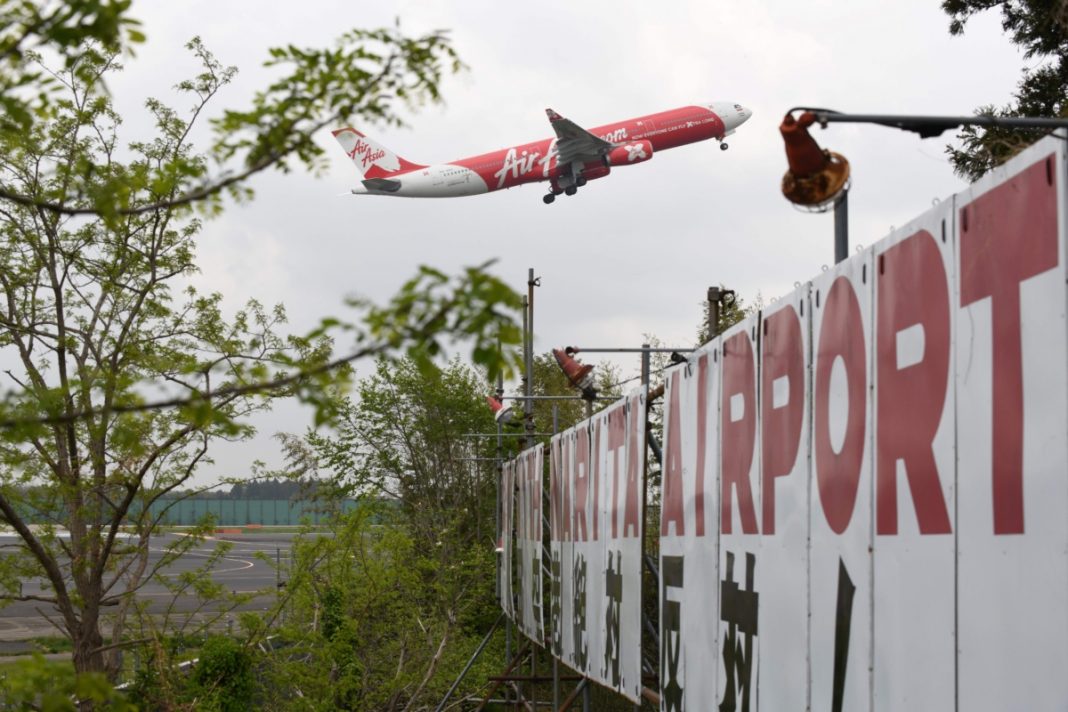If you look carefully when flying into or departing from Narita Airport, you may catch sight of farmland and small houses sandwiched between the taxiways. This is the result of strong opposition from local farmers to airport development, which left the airport being developed around the land of farmers who refused to move.

The story of how this came to happen tells us a lot about the history of airport development in Japan, the strength of land rights, and the determination and values of the people.

Farming within the airport
It is very unusual to find anything within an airport development that does not belong there. Space is needed for runways, taxiways, and aircraft storage, and there are obvious security concerns. This makes it all the more surprising that Tokyo’s Narita International Airport contains a large patch of farmland, these days with five remaining farms and residences. These are operational farms, still growing produce and selling it locally.
The BBC recently looked at this and spoke with one of the farmers still living there, Takao Shito. You can watch this in the video below/
This farmland area has been there since long before Narita airport was built. Following heavy protests at the time of its construction, a number of farmers refused to move, and five remain there to this day. To understand the story, we start back when the surrounding area was mostly all farmland.

Background and construction of Narita airport
Back to the 1960s – the need for a second airport for Tokyo
Haneda airport opened in 1931 as Tokyo’s main airport. It was built on previously reclaimed land in Tokyo Bay. Over the decades, the airport grew from its original 300-meter runway and small terminal, but this reached a limit.

In the 1960s, the Japanese government looked at options to expand capacity. Haneda was already nearing its limits, and there was a strong growth forecast. The 747 was due to arrive in 1970 (and larger jet aircraft were already operating at Haneda), and in 1964 Japan lifted restrictions on travel for its own citizens.
Expanding Haneda was an option, and plans were drawn up for expansion and the addition of a new runway. This would still have limits, however, with the bay and surrounding urban and industrial development impacting expansion. It was thought that any expansion undertaken would only cover around the next 10 years of growth. With this in mind, the government decided to build a new airport.
There were also issues with pollution and noise disturbance. Haneda was built before the arrival of jet aircraft. Although such aircraft were restricted in hours of operation from 1962 (according to an OECD report on Japan’s airports), this was a significant consideration in further expansion.

Selecting a location in Chiba province
Several locations were studied by the Japanese Transport Ministry from 1963, and in 1965 it selected a site near the village of Tomisato. This was in the rural Chiba province, located well outside central Tokyo. Such a location would allow large scale construction (with room for expansion) and also alleviate some of the problems with noise and pollution faced at Haneda.

Tomisato, however, was a heavily farmed area, and the construction would mean the removal of around half of the villages and farms. There had been minimal discussion, however, with local farmers, and they soon launched an opposition.
Fearing delays to the airport, the government acted quickly (by June 1966) to move the airport location around five kilometers away to Sanrizuka and Shibayama villages. A large part of the land there was state-owned, and it was hoped this would lessen opposition. Perhaps it did, but it was still to become a significant problem.
Sanrizuka and Shibayama – a rural past
This part of Chiba province had long been farmland. In around the year 700, the Emperor created farmland and pasture there. It remained predominately agricultural until the 20th Century when it became the Japanese Imperial Family’s farmlands (called Goryo Farm).

The Imperial Family began selling off parts of the area in the 1920s, and much more was sold after the Second World War. But it remained agricultural, with the post-1920s occupants mainly being former samurai households and their workers, then later poorer settlers moving in to farm the land.
The strong attachment to the land they had worked hard to clear and farm was perhaps one of the factors that made landowners so attached to their farms here, and so vehemently opposed to the airport.
Building Narita airport
Construction of the airport began in the late 1960s. The first terminal building was completed in 1972, and the first runway in 1978. Disruption from locals had delayed this construction. And it even delayed the opening of the airport. This was initially scheduled for March 1978. However, it was postponed to May after protesters broke into the airport site and even the control tower, causing extensive damage.
The original government plans for the airport noted it could have up to five runways. This has never happened, and even the construction of the second runway proved difficult. It was not until 2002 that the second runway was opened, with more delays caused by protesters. It even had to be built shorter than planned (2,180 meters instead of 2,500 meters) due to blockages created by protesters.

As well as delays in construction, the ongoing protests have led to a heavy security presence at the airport. The opening ceremony had a 14,000-strong police attendance. And for a long time (from opening right up until 2015), anyone entering the airport had to show identity.
The Sanrizuka struggle and opposition
So, what caused such heavy and long-lasting protests? The original problem came from a lack of consultation with local farmers and landowners when selecting the airport site.
The farmers were angry and demonstrated their opposition right from the announcement of construction plans. But the opposition grew in strength and organization when left-wing political parties joined the farmers. This group organized itself into the Sanrizuka-Shibayama Joint Anti-Airport Union.
Student activists joined the movement as well, boosting numbers. There had been earlier violent demonstrations from students over the US-Japan security treaty, and growing support for anti-government struggles. These attempts by the government to seize the fields and farms to build an airport were seen in the same light as other major struggles.

The Union staged protests, sit-ins, and petitions throughout the construction of the airport. These often turned violent and resulted in the deaths of several protesters and riot police over the years.
As well as protests, the Union built structures to disrupt airport construction. Several structures, including forts, bunkers, and underground obstructions, were built on land that had not been purchased for development. And in 1972, the Union constructed a 60-meter tower on the main runway approach to disrupt test flights. It was not until May 1977 that authorities gained control of the area surrounding it and could remove the tower.

Long term opposition
By the time the airport opened, the struggles had been going on for a decade. These were not part-time protests – many participants became fully committed to the opposition. Some moved into the disputed areas, and watches were maintained 24 hours a day from towers and huts built there (as this report by Japanese counterculture blog Throwoutyourbooks recalls).
And the protests did not end with the opening of the airport. Despite the death of the Union leader, Issaku Tomura, and ongoing negotiations with participants, there was further opposition and significant delays to constructions.
In coverage of the ongoing protests in 1989, the New York Times summarised the simple cause of annoyance. It writes:
“The key to the issue remains what it has always been: amazingly stiff opposition based on the seeming highhandedness in the way the Government forced the airport on local landowners without consulting them.”

Compensation for farmers
From 1968, the government offered compensation to local farmers who left their land. With growing opposition, though, and violent and active means of disruption, this became increasingly difficult.
Many took up the offer, gradually reducing the number of farms and houses standing in the way of construction. Under Japanese law, the government did have the right to take control of the land. And this was enacted to a certain extent in 1971, with authorities forcibly taking control of some areas.
While the government took control of some of the land, some areas remained occupied by villagers as construction proceeded. According to reporting in the New York Times, as of 1989, eight families had refused to move. This left 53 acres (2% of the total airport area) still occupied. The government could force the sale of these final but chose not to, for fear of further escalation of the protests and violence.
In his discussions with the BBC, Takao Shito recalls how he was offered compensation of 180 million Yen ($1.7 million). Other families who refused to move were likely offered the same. For him, though, it was not about the money; he was determined to stay no matter what.
Just five farms left today
This takes us to where we are today, with farming still carrying on. Takao Shito described his area – before the airport, there were 28 households in his village and 66 in the other village. Now just five remain.

The protests from the Sanrizuka groups have mostly ended, although there are still occasional meetings and demonstrations. The blog Throwoutyourbooks recalled in 2014 the status of the remaining protesters who hang on, saying,
“The authorities continue to take these seriously and the police presence is high, despite the far smaller numbers of participants than in yesteryears. The original farmers are dying off and the ‘protestors,’ while not without some hardcore youthful political activists from Zengakuren, are mostly elderly.”
The remaining farmland though, is the evidence of their success. Yes, the airport may have been built, but its quite a testament to having had the airport constructed around their land.
Takao Shito continues to farm, assisted (as he describes to the BBC) by around 10 volunteers, many of them former protesters themselves. He refers to the excellent land, farmed for 100 years by his family. And with the slowdown in aviation in 2020, it is even better for him, with less pollution and noise.
He sums up well the length of struggle and determination of the farmers, explaining:
“I’m not in it for the money. I want to continue farming… Nothing gives me greater joy.”
Learning the lessons when building Osaka
The Sanrizuka struggle took its toll on the airport, its builders, and, ultimately, the airlines and passengers using it. It was delayed in opening, and in expanding, saw increased costs, and has never realized its full potential scale.
Talking about the airport in 1989, Geoffrey Tudor, director of public relations for Japan Air Lines, said:
“It’s like a curse was placed on that site. It was the wrong site, and we’re never going to be able to forget that.”
In the 1970s, a similar decision was reached in Osaka that a second airport was needed. Its first airport, Itami, was nearing capacity and had the same issues with dense urban surroundings and problems with pollution and noise.

Planners soon settled on not only a location remote from the city but a new artificial island to house the airport. The protests and disruptions seen at Narita were a significant factor in this decision; with this location, any issues with land expropriation (and noise disruption) could hopefully be avoided.

This was mostly true, although there were protests at quarry sites. The airport, however, suffered from different problems, most significantly the ongoing sinking of its island. For more details on the fascinating Kansai airport, its airport construction, and ongoing problems, see our guide.
Would you like to share your thoughts on the developments and challenges of Narita airport? Do you know any more details about the Sanrizuka struggles or the ongoing farming at the airport? Let us know in the comments.



